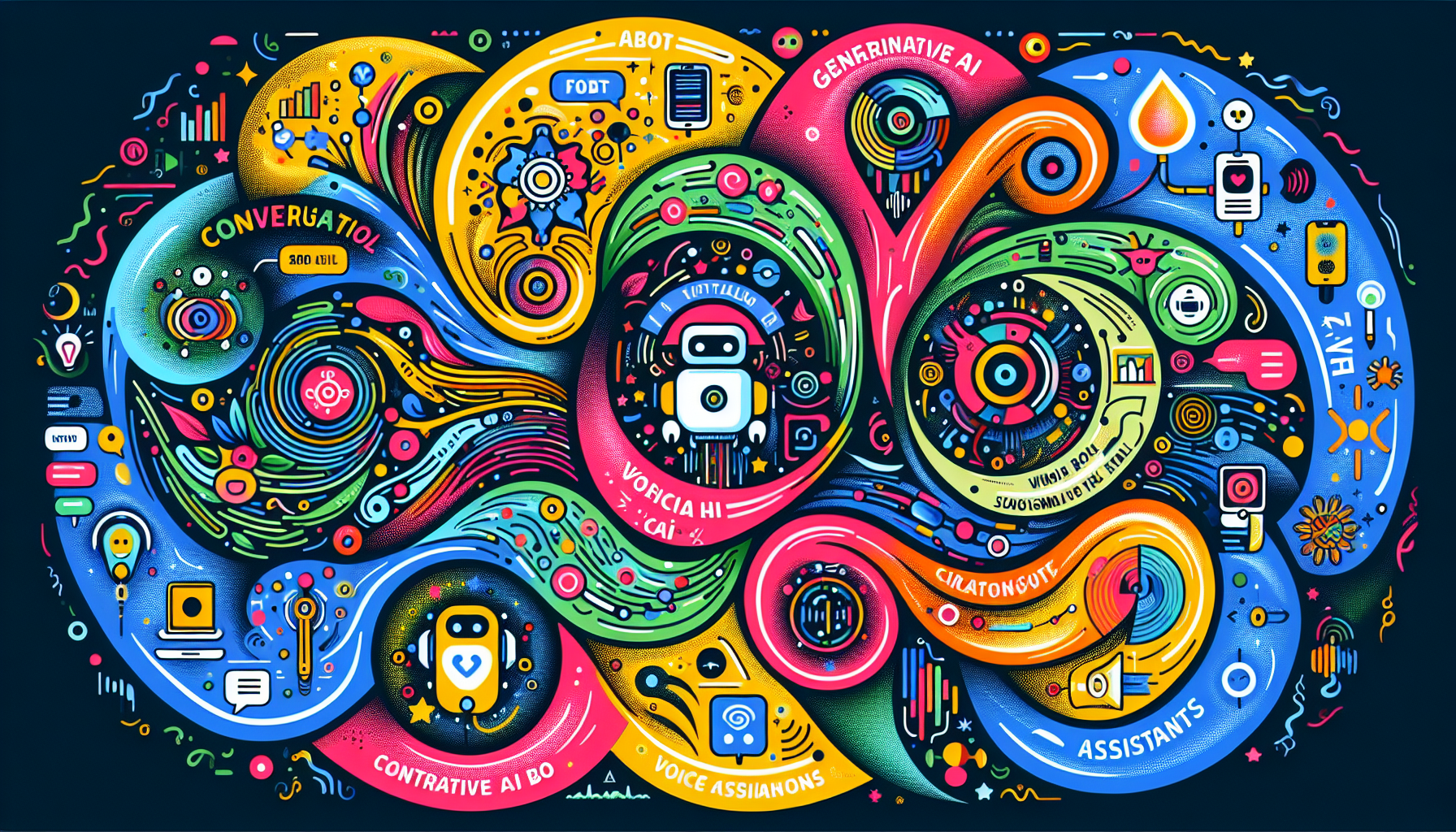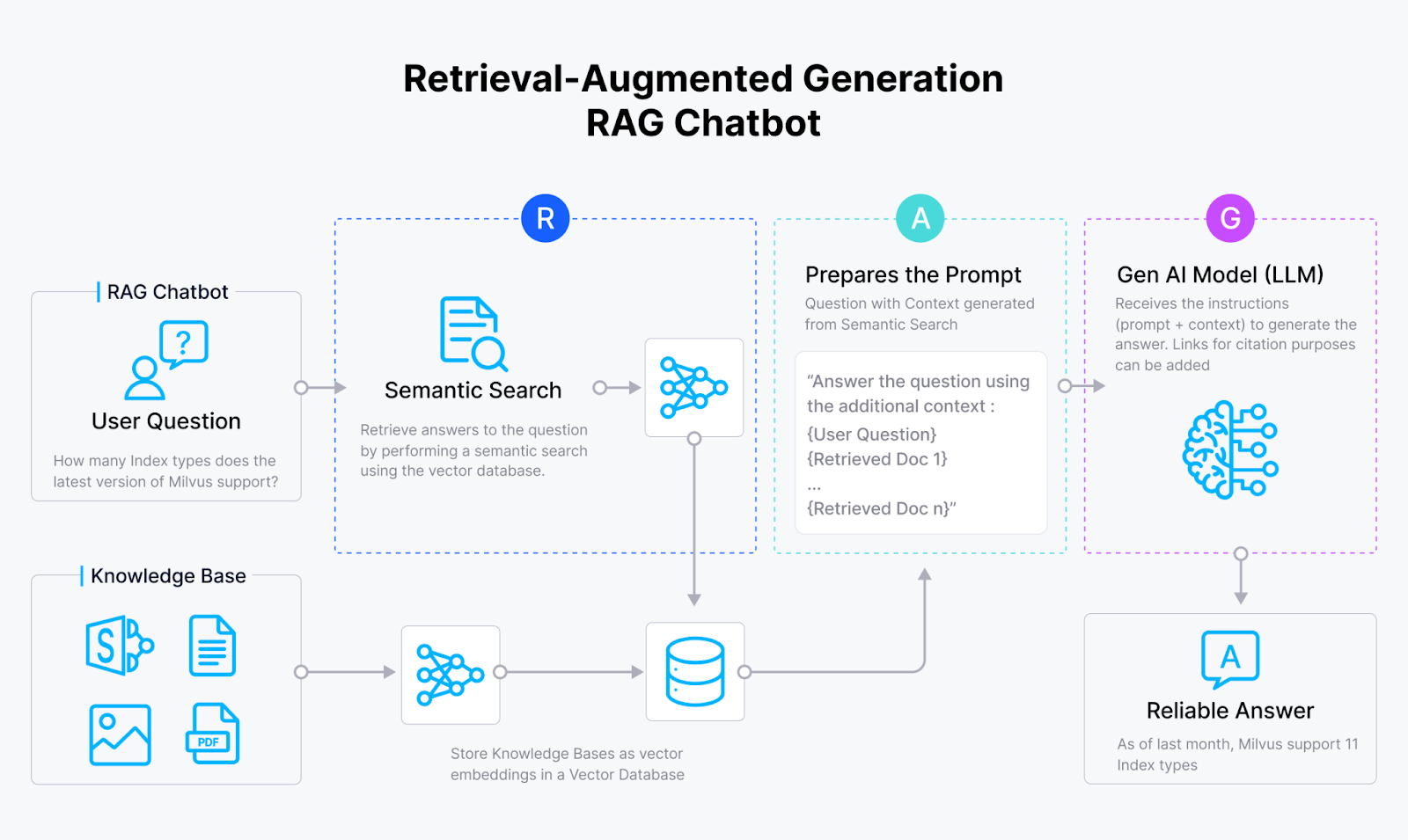What is Conversational AI?

TL;DR: Conversational AI is a specialized branch of artificial intelligence that enables computers to conduct conversations with humans in a way that feels natural and intuitive. This technology allows machines to engage in dialogues by interpreting and responding to spoken or written language, effectively mimicking human conversation through either text or voice.
What is Conversational AI?
Conversational AI transforms how we interact with the digital world, from ordering pizza through a chatbot to asking a virtual assistant to play our favorite song. These interactions mimic human conversation and are powered by advanced technologies that understand and process language. Whether speaking to Siri about the weather, typing a question to a customer support bot, or using a voice-activated system to control your smart home, conversational AI is behind the scenes, enhancing our daily digital interactions.
In this blog, we'll explore conversational AI, the technologies that drive it, and how it's being implemented across various industries.
Understanding Conversational AI
 An illustration depicting conversational AI technology in action..png
An illustration depicting conversational AI technology in action..png
Conversational AI is a specialized branch of artificial intelligence that enables computers to conduct conversations with humans in a way that feels natural and intuitive. This technology allows machines to engage in dialogues by interpreting and responding to spoken or written language, effectively mimicking human conversation through either text or voice.
The backbone of conversational AI is its reliance on advanced technologies such as [natural language processing (NLP)](Advancements in machine learning and emerging NLP techniques, such as transformer models, are continually refining the capabilities of conversational AI. These technologies allow conversational AI to learn from past interactions, improving its responses over time to ensure they are more accurate, context-aware, and relevant. This learning capability is what makes conversational AI an invaluable tool for driving deeper engagement and providing a user-friendly interface for all kinds of digital interactions, from customer service to personal assistants.) and machine learning. These tools allow the AI to dissect and comprehend the content and intent behind a user's message. It then crafts responses that combine both predetermined scripts and insights gleaned from previous interactions. For instance, when you instruct a voice assistant like Siri to "set an alarm for 7 AM," it uses NLP to interpret your command and promptly sets the alarm, confirming with, "Alarm set for 7 AM."
The utility of conversational AI extends across a wide range of applications. It powers customer service bots that provide 24/7 query resolution, personal assistants that help with daily scheduling and reminders, and interactive voice response systems that facilitate navigation through phone menus. These systems execute direct commands and continuously learning from user interactions to enhance the relevance and precision of their responses.
One of the greatest strengths of conversational AI lies in its capacity to deliver personalized and efficient service at scale, autonomously. This makes it an indispensable asset for businesses aiming to enhance customer satisfaction and optimize operational efficiency. As conversational AI technologies evolve, they are becoming more ingrained in our daily lives, progressively refining the future landscape of human-computer interaction.
How Conversational AI Works
Conversational AI simplifies and enhances interactions between humans and machines, creating conversations that feel both natural and intuitive. The technology achieves this through a series of well-orchestrated stages: input processing, natural language understanding, dialogue management, natural language generation, and output generation. Here's a closer look at each stage:
Input Processing: This first step involves capturing and interpreting the user’s input, which can be in the form of text or voice. Voice inputs are converted into text using speech recognition technologies, ensuring the system can understand and process the user's request.
Natural Language Understanding (NLU): At this stage, conversational AI uses natural language processing (NLP) to decipher the content and intent behind the user's message. NLP allows the machine to parse and understand human languages in a way that captures the nuances and contextual cues necessary for accurate response generation.
Dialogue Management: This component is crucial for maintaining the flow of the conversation. Dialogue management tracks the context and state of the conversation to provide responses that are not only relevant but also coherent over the course of the interaction. This ensures the conversation progresses logically and naturally.
Natural Language Generation (NLG): Here, conversational AI crafts responses based on the dialogue's current context. NLG involves transforming the machine’s decision-making process into human-like language, creating replies that are clear, appropriate, and engaging.
Output Generation: In the final step, the generated text is delivered to the user. If the initial input was voice-based, this text might be converted back into speech, providing a seamless conversational experience.
Advancements in machine learning and emerging NLP techniques, such as transformer models, are continually refining the capabilities of conversational AI. These technologies allow conversational AI to learn from past interactions, improving its responses over time to ensure they are more accurate, context-aware, and relevant. This learning capability is what makes conversational AI an invaluable tool for driving deeper engagement and providing a user-friendly interface for all kinds of digital interactions, from customer service to personal assistants.
Converstation AI vs. Generative AI
 A diagram explaining how conversational AI works..png
A diagram explaining how conversational AI works..png
Conversational AI and Generative AI are both branches of artificial intelligence, but they serve different purposes and are designed with distinct capabilities.
Conversational AI is specifically designed to facilitate interaction between humans and machines using natural language. It focuses on understanding and generating human-like responses in a conversational context. On the other hand, Generative AI refers to the broader capability of AI systems to generate new content, from text and images to music and video, based on learned data patterns. It is not limited to text and encompasses a wide range of media. Interestingly, many AI tools combine both conversational AI and generative AI technologies to enhance their capabilities.
For example, a system may process user input with conversational AI and generate responses using generative AI, addressing more complex or unconventional queries. The integration of these technologies allows businesses to provide more dynamic and versatile AI-powered solutions, meeting a broader range of customer needs and enhancing overall user experience.
Key Benefits of Conversational AI
Conversational AI offers a wealth of advantages that are transforming businesses across numerous sectors. Here's a closer look at some of the most impactful benefits:
Enhanced Customer Experience: Conversational AI streamlines support by quickly addressing inquiries and providing timely help. This efficiency significantly improves the overall customer experience.
Efficient Handling of Repetitive Queries: It automates responses to frequently asked questions, freeing up human agents to focus on more complex issues.
Scalability of Interactions: The ability of conversational agents to manage a large volume of interactions showcases their essential role in modern customer service frameworks, reflecting an increasing dependence on these technologies.
Enhancing Customer Satisfaction
Conversational AI is like having a helpful assistant available 24/7, ready to answer customer questions at any time. This constant availability means that no matter when a user reaches out—be it late at night or early in the morning—they’ll get the help they need. By taking on these routine inquiries, conversational AI frees up human support teams to tackle more complex challenges, which in turn improves the overall quality of customer service.
What makes conversational AI truly stand out is its knack for personalization. It remembers user preferences and past interactions, crafting responses that are tailored just for the individual. This personalized touch not only automates mundane tasks but also makes services feel more thoughtful and tailored to each user. As a result, every interaction feels more engaging and relevant.
Moreover, AI-powered virtual assistants streamline these interactions, making them smoother and more efficient. This efficiency translates into quicker, more precise answers, significantly boosting customer satisfaction. The experience is smoother, quicker, and leaves customers feeling heard and valued—an essential component of excellent customer service in today’s fast-paced world.
Reducing Operational Costs
Introducing chatbots into your business operations isn't just a tech trend; it's a cost-saving powerhouse. Industry estimates show that businesses could save as much as $8 billion annually worldwide by leveraging these AI tools. The core advantage of deploying conversational AI lies in its ability to save both time and money. By automating routine tasks, these systems not only speed up operations but also greatly reduce the chances of human error and inefficiencies, which in turn cuts costs.
Conversational AI systems have the capability to handle many customer interactions at once—far more than human agents could manage simultaneously. This capacity leads to notable cost reductions. For instance, businesses typically save around 4 minutes per customer inquiry when using chatbots.
Moreover, chatbots enhance customer service by offering self-service options that diminish the need for human intervention. This automation of tasks usually handled by staff not only trims expenses but also streamlines the entire customer interaction process, making it faster and more error-free. This approach doesn't just save money; it transforms customer service into a smoother, more responsive experience.
Boosting Sales and Engagement
Tailored recommendations powered by conversational AI not only boost customer satisfaction but also actively engage customers during their shopping journey. By effectively addressing concerns and queries in real-time, conversational AI helps enhance the shopping experience, ultimately leading to increased sales and fostering business growth.
Beyond just driving sales, conversational AI significantly improves the quality of customer interactions. It personalizes the customer experience by catering to individual preferences and needs, ensuring that each interaction is as relevant and helpful as possible. This level of personalization makes customers feel valued and understood, strengthening their relationship with the brand.
Types of Conversational AI Technology
 A visual representation of different types of conversational AI technology..png
A visual representation of different types of conversational AI technology..png
Conversational AI platforms consist of a variety of technologies that empower machines to participate in human-like conversations by understanding and responding to questions in a contextually appropriate manner. These platforms range from traditional chatbots to advanced generative AI bots and voice assistants, each offering unique features and potential uses. Understanding the different types of conversational AI technologies helps businesses select the right tools for their specific needs and goals.
Traditional Chatbots
Traditional chatbots operate on a set of predefined rules and are often used in customer service to handle straightforward inquiries. Their predictability and reliability make them ideal for providing consistent responses. However, because they follow a fixed set of rules, these chatbots lack flexibility and struggle with personalization. Their limited capacity to interpret nuanced language can also hinder their effectiveness in more complex conversations.
Generative AI Bots
Generative AI bots represent a leap forward in conversational technology. These bots use sophisticated AI models like OpenAI's GPT series or Google's Gemini series to generate context-aware, tailored responses. Capable of searching through extensive knowledge bases to pull relevant information or summarize content, generative AI bots handle intricate and nuanced dialogues. They continuously learn from each interaction, progressively improving their responses and thus greatly enhancing the user experience.
RAG-based Chatbots
As AI evolves, large language models (LLMs) such as GPT are increasingly integral to developing conversational AI applications, including sophisticated chatbots. These models generate content by drawing on patterns and information from the data on which they were trained. However, their ability to generate accurate responses is confined to the scope of their training data. When asked questions outside this scope, they tend to "hallucinate," producing responses that can be misleading or entirely incorrect.
Retrieval Augmented Generation (RAG) is a robust solution for reducing LLM hallucinations, especially when queries require specific knowledge outside the model’s training data, by connecting the LLM with external data sources. A standard RAG setup combines an LLM (like ChatGPT), a vector database (such as Milvus or its managed version, Zilliz Cloud), and an embedding model. Developers can build even more advanced RAG systems by integrating additional tools like LlamaIndex, LangChain, DSPy, or rerankers, each tailored to enhance retrieval, re-ranking, or other specialized tasks for more accurate and relevant outputs.
 Figure- RAG workflow.png
Figure- RAG workflow.png
Here is how RAG works:
Vectorization: Instead of sending the input query directly to the LLM, an embedding model first encodes the query and any additional knowledge sources into vector embeddings, respectively.
Vector Storage: These vector embeddings are then stored in a vector database like Milvus or Zilliz Cloud, which efficiently manages large volumes of vectorized data for fast retrieval.
Vector Similarity Search: The vector database performs a similarity search, identifying the top-k results that match the context and semantics of the user’s query.
Passing Context to the LLM: The top-matching results from the vector search are fed into the LLM alongside the original query. This provides the LLM with relevant, up-to-date information, helping to reduce hallucinations and improve response accuracy.
Generating the Final Response: The LLM combines its pre-trained knowledge with the retrieved context to produce a more accurate, well-informed response.
This approach enables the LLM to handle complex or specific questions effectively, even when it lacks direct training on the topic.
Voice Assistants
Voice assistants are AI-driven applications that facilitate voice interactions, turning spoken commands into actions by interpreting user intent. Examples include Amazon's Alexa, Google Assistant, and Apple's Siri. These assistants are integral to various devices like smartphones, smart speakers, and vehicles, offering users the convenience of hands-free operations. Whether it’s managing appointments, processing payments, or controlling smart home devices, voice assistants are expanding their role in daily activities, changing how we interact with technology and boosting customer engagement through seamless, natural interactions.
Implementing Conversational AI in Your Business
Integrating conversational AI into your business involves several strategic steps that begin with setting clear objectives and identifying impactful use cases. This approach ensures that the AI solutions you choose are tailored to meet specific business needs and are capable of boosting productivity.
Setting Goals and Identifying Use Cases
The journey to deploying conversational AI starts with a clear definition of its purpose. Determine what you aim to achieve—whether it’s improving customer service, increasing sales, or automating routine tasks. Identifying which aspects of your business will benefit most from conversational AI is crucial for harnessing its potential effectively. Once these goals are defined, you can measure the success of your AI initiatives against them, ensuring they deliver tangible benefits and align with your overall business strategy.
Choosing the Right Platform
Selecting the appropriate conversational AI platform is critical and should align with your existing technology infrastructure. Consider a platform’s scalability—can it grow as your business needs evolve? It’s also important to check how well it integrates with your current systems and its ease of use for both your team and your customers. Platforms that offer visual interfaces and low-code options can dramatically simplify the development process, making advanced conversational AI accessible even for smaller teams. Look for features like omnichannel support and intuitive chatbot builders to further enhance the functionality and reach of your AI tools.
Measuring Performance and ROI
To truly understand the impact of conversational AI on your business, it’s essential to measure its performance and return on investment (ROI). This can be done by collecting and analyzing data on customer interactions, soliciting direct feedback through surveys, and utilizing quality assurance tools to monitor the quality of interactions. Important metrics to track include customer satisfaction scores and the effectiveness of AI responses. Establishing specific customer service key performance indicators (KPIs) during the planning phase can provide a clear benchmark for evaluating success and identifying areas for improvement.
By taking these structured steps, businesses can ensure that their investment in conversational AI is sound, strategic, and capable of delivering significant improvements in both customer engagement and operational efficiency.
Future Trends in Conversational AI
 An illustration depicting future trends in conversational AI..png
An illustration depicting future trends in conversational AI..png
Keeping pace with the rapid advancements in conversational AI is crucial for businesses aiming to capitalize on its evolving capabilities. As we look ahead, several key trends are poised to redefine how conversational AI impacts our daily interactions and business operations.
Advances in Natural Language Processing (NLP)
Natural language processing is continually advancing, with newer technologies enhancing how conversational AI understands and interacts with human language. Recent developments in NLP, such as transformer models and contextual embeddings, have significantly improved the ability of these systems to grasp nuances in language, including context and subtle intents. Looking forward, we expect to see NLP incorporating multimodal capabilities, allowing conversational AI to process and analyze inputs not just from text and voice, but also from images and other sensory data. This evolution will make interactions with AI more comprehensive, personalized, and contextually aware, dramatically enhancing user engagement.
Integration with IoT and Smart Devices
Another exciting trend is the integration of conversational AI with the Internet of Things (IoT) and smart devices. This integration promises to transform user experiences by enabling more interconnected functionality. Conversational AI is set to become the central interface in IoT ecosystems, offering users seamless control over their smart environments—from home appliances to wearable technology. This synergy between conversational AI and IoT devices is expected to bring a new level of automation, intelligence, and personalization to our interactions with technology, making everyday tasks more convenient and efficient.
Ethical Considerations and AI Governance
As conversational AI becomes more integral to our lives, addressing ethical considerations and establishing robust AI governance frameworks become imperative. It is crucial for organizations to operate transparently, letting users know when they are interacting with AI. This transparency helps build trust and clarifies the nature of user-AI interactions. Furthermore, companies must conduct regular audits to detect and mitigate any biases in AI systems, ensuring fairness and ethical integrity. Upholding high standards of transparency and accountability will be essential for maintaining public trust and fostering the responsible use of conversational AI.
Summary
In summary, conversational AI represents a transformative shift in how businesses interact with their customers. By leveraging advanced technologies such as natural language processing, machine learning, and generative models like GPT, conversational AI can simulate human conversation, providing efficient and personalized interactions that enhance customer satisfaction and operational efficiency.
The benefits of conversational AI are vast, from reducing operational costs and boosting sales to improving customer engagement and satisfaction. With the right implementation strategy, businesses can harness the full potential of conversational AI to drive growth and innovation.
As we look to the future, staying updated on the latest advancements and addressing ethical considerations will be crucial for maximizing the impact of conversational AI. Embracing this technology can lead to more dynamic and effective customer interactions, setting businesses apart in an increasingly competitive landscape.
Frequently Asked Questions
What is conversational AI?
Conversational AI is a remarkable technology that allows machines to engage with us in a natural, human-like way. Embracing it opens up exciting possibilities for better communication and more intuitive interactions!
How does conversational AI work?
Conversational AI works by processing input, understanding natural language, managing dialogue, and generating responses, allowing it to engage effectively with users. Embrace this technology for seamless interactions and elevated experiences!
What are the benefits of implementing conversational AI in a business?
Implementing conversational AI in your business significantly enhances customer satisfaction with 24/7 support, cuts operational costs through automation, and drives sales with personalized interactions. Embrace this technology to elevate your customer experience and streamline operations!
How do generative AI and conversational AI differ?
Generative AI creates new content by learning from existing data, while conversational AI understands human speech to provide appropriate responses. Embracing both can lead to even more powerful tools!
What are some examples of conversational AI in action?
Conversational AI is revolutionizing customer support, helping businesses provide personalized recommendations and round-the-clock assistance in areas like HR, IT services, and e-commerce. Embrace these innovations to enhance engagement and satisfaction!
- Understanding Conversational AI
- How Conversational AI Works
- Converstation AI vs. Generative AI
- Key Benefits of Conversational AI
- Types of Conversational AI Technology
- Implementing Conversational AI in Your Business
- Future Trends in Conversational AI
- Summary
- Frequently Asked Questions
Content
Start Free, Scale Easily
Try the fully-managed vector database built for your GenAI applications.
Try Zilliz Cloud for Free